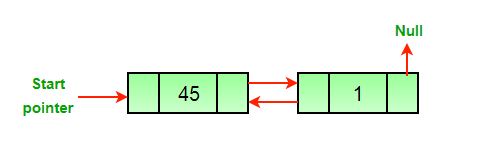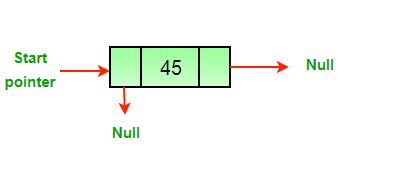C# Program For Deleting A Node In A Doubly Linked List
Last Updated :
15 Dec, 2021
Pre-requisite: Doubly Link List Set 1| Introduction and Insertion
Write a function to delete a given node in a doubly-linked list.
Original Doubly Linked List

Approach: The deletion of a node in a doubly-linked list can be divided into three main categories:
- After the deletion of the head node.

- After the deletion of the middle node.

- After the deletion of the last node.

All three mentioned cases can be handled in two steps if the pointer of the node to be deleted and the head pointer is known.
- If the node to be deleted is the head node then make the next node as head.
- If a node is deleted, connect the next and previous node of the deleted node.

Algorithm
- Let the node to be deleted be del.
- If node to be deleted is head node, then change the head pointer to next current head.
if headnode == del then
headnode = del.nextNode
- Set next of previous to del, if previous to del exists.
if del.nextNode != none
del.nextNode.previousNode = del.previousNode
- Set prev of next to del, if next to del exists.
if del.previousNode != none
del.previousNode.nextNode = del.next
C#
using System;
public class DLL
{
Node head;
public class Node
{
public int data;
public Node prev;
public Node next;
public Node(int d)
{
data = d;
}
}
public void push(int new_data)
{
Node new_Node = new Node(new_data);
new_Node.next = head;
new_Node.prev = null;
if (head != null)
head.prev = new_Node;
head = new_Node;
}
public void printlist(Node node)
{
while (node != null)
{
Console.Write(node.data + " ");
node = node.next;
}
Console.WriteLine();
}
void deleteNode(Node del)
{
if (head == null || del == null)
{
return;
}
if (head == del)
{
head = del.next;
}
if (del.next != null)
{
del.next.prev = del.prev;
}
if (del.prev != null)
{
del.prev.next = del.next;
}
return;
}
public static void Main()
{
DLL dll = new DLL();
dll.push(2);
dll.push(4);
dll.push(8);
dll.push(10);
Console.Write("Created DLL is: ");
dll.printlist(dll.head);
dll.deleteNode(dll.head);
Console.Write(
"List after deleting first node: ");
dll.printlist(dll.head);
dll.deleteNode(dll.head.next);
Console.Write(
"List after Deleting middle node: ");
dll.printlist(dll.head);
}
}
|
Output:
Original Linked list 10 8 4 2
Modified Linked list 8
Complexity Analysis:
- Time Complexity: O(1).
Since traversal of the linked list is not required so the time complexity is constant.
- Space Complexity: O(1).
As no extra space is required, so the space complexity is constant.
Please refer complete article on Delete a node in a Doubly Linked List for more details!
Share your thoughts in the comments
Please Login to comment...